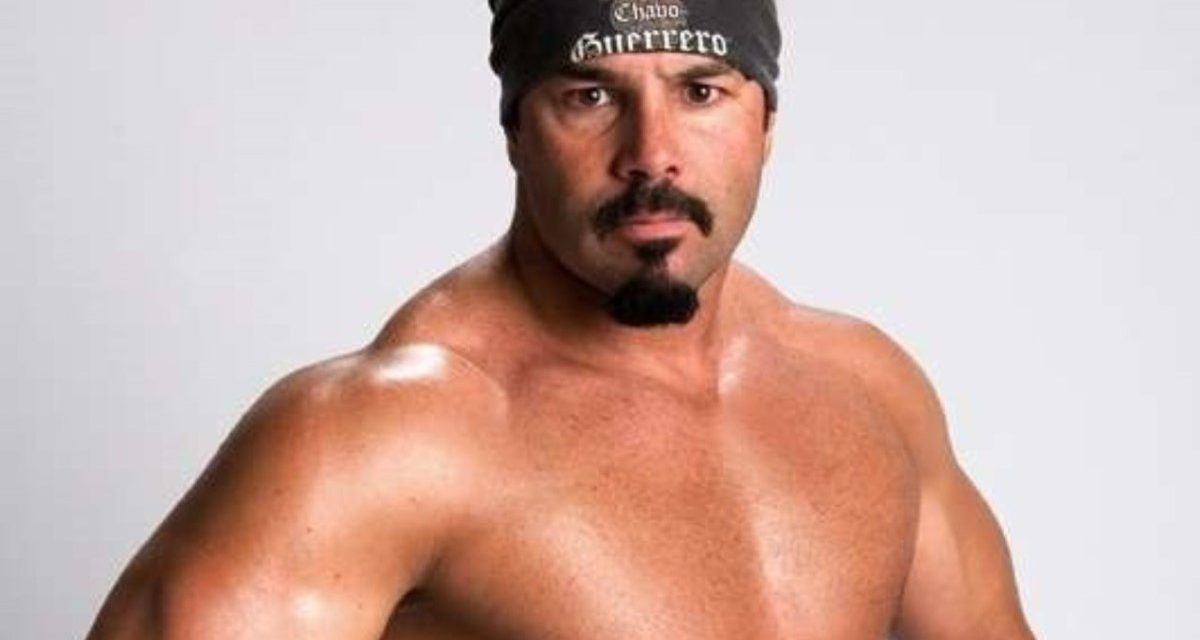So, you need someone to train actors to get into the ring and fill the wrestling boots of some iconic names — who do you call? Chavo Guerrero, Jr., who had a hand in the Emmy-winning stunt choreography of Netflix’s GLOW series, took that call from the Young Rock production team and found himself in Australia putting together, among other things, a fantasy-league level battle royal match for the show. This is all part of Guerrero’s second career, as it were, as he has become a sought-after behind-the-scenes wrestling coordinator.
Guerrero spoke with Slam Wrestling about about life after full-time in-ring competition, the evolution of wrestling as portrayed in film and on TV, and why being a good worker doesn’t always equate to being a good teacher.
Guerrero was, of course, essentially pre-destined to get into the wrestling business considering his family ties. “Well, besides playing for the Dallas Cowboys, it was only wrestling and that’s it,” he says with a laugh when asked if he ever had any other plans for his career as a kid. “If I look at my sixth grade yearbook, where they asked what do you want to do, mine was professional wrestler.”
What people may not be as familiar with, though, were the family’s connections to Hollywood. “My uncle Mando transitioned into Hollywood and became a stunt man,” Guerrero begins. “And my dad did a couple movies — he was in The One and Only with Henry Winkler, but he was just so focused on wrestling.”
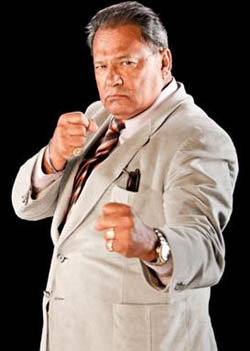
Chavo Guerrero, Sr.
Indeed, Chavo Guerrero, Sr. only appeared in a couple more films — and if you’d be forgiven for not finding Alligator II: The Mutation (1991) or Streets of Rage (1993) at the multiplex. Mando, on the other hand, dove headlong into Hollywood work as both an actor and a stuntman. He worked on the seminal wrestling films Bad Guys (1986) and Grunt! The Wrestling Movie (1986), also appeared in Streets of Rage, and lent his talents to several big Hollywood projects.
Somewhat poetically, Mando was also the trainer and wrestling coordinator for the original Gorgeous Ladies of Wrestling series (1986-1989). As detailed by Lisa Moretti, known as Tina Ferrari in GLOW and Ivory in the WWE, in a 2000 interview with Slam Wrestling, Mando took a no-nonsense approach to training the women in the ring, and demanded a seriousness from them when it came to their training.
Moretti describes a moment where Mando, who had been warning the women to pay attention during training, found his patience exhausted: “He just hopped right up in lickety-split time, and grabbed this big, voluptuous blonde by the hair, threw her down to the mat, tied her up into a pretzel. She was crying. I thought to myself, ‘Man, I like this guy.'”
Fast forward nearly 20 years, and Chavo Guerrero, Jr. found himself training the next generation of GLOW wrestlers. While he didn’t share any stories of jumping in the ring and tying anybody up in a pretzel, his passion for helping them be at their best matches his uncle’s.
Guerrero vividly remembers the reaction of the actors after their first performance in front of a crowd after all of their hard work. “No one really knew what to expect,” he recalls. “Then you had Alison Brie and Betty Gilpin come in and tear it down, and these actresses said, ‘Oh my god, I’ve never felt this way ever before in my life, in any scene,’ because those fans were really reacting, they were really cheering.”
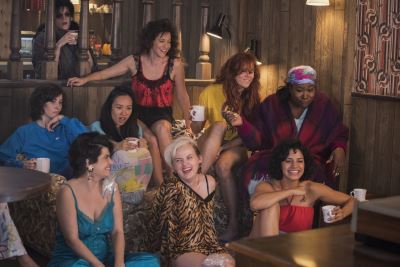
The cast of actors turned wrestlers in Netflix’s GLOW
It’s a reaction that Guerrero had become accustomed to, but not hardened against. Being in the ring and working a crowd had been his livelihood since 1994, but as he explained in a 2014 interview with Slam Wrestling, he had compelling reasons to step away from full-time wrestling: his family. “I missed so much of my kids’ life, now I coach their football and basketball teams and the sports I don’t coach I make sure I am at every game and practice,” Guerrero explained.
Looking back on that time in his life, Guerrero is profoundly confident in having made the right decision. “When I stepped away from (wrestling), my oldest was 12 and my youngest was nine,” he says. “The WWE schedule is so demanding, especially back then it was so demanding. I didn’t want them to grow up without a dad. That was all great, and then you remember you’ve got to put those kids through college, so how am I going to do this?”
“I got a call from Lucha Underground,” he continues, speaking of the series created by TV producer Mark Burnett (Survivor) and director Robert Rodriguez (the El Mariachi series). “They brought me in as a producer, and that transitioned to supervising producer, sort of morphing into wrestling coordination and stunt coordination and producing. It really started me off.”
As someone with an innate skillset seeking new ways to utilize his talents, Guerrero discovered what he describes as the perfect type of wrestling work. “I always said about wrestling that it would be the perfect job if I could sleep in my own bed every night,” he explains. “I’m still doing wrestling in Hollywood, and able to sleep in my own bed every night. I’ve been home so much, but I’m working.”
Of course, being given the opportunity to train for wrestling on TV and coordinate matches is only the first part. While teaching does not come easily to everyone, no matter how skilled they are, Guerrero explains that he knew long ago that he had a natural inclination for training. “I learned early on that I was a good coach, that I was able to convey my thoughts and things that I’ve learned and pass them on to other people,” he says. “I remember people at WWE trying out, and me and Undertaker would pull them aside to talk to them. Of course there were agents, but (the new wrestlers) wanted to hear sometimes from people on the active roster.”
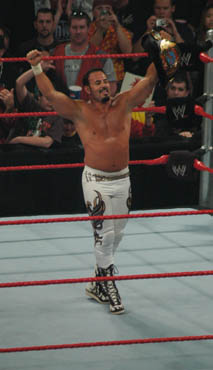
Chavo Guerrero in WWE in February 2008. SlamWrestling file photo
On top of that, however, Guerrero had to learn new ways to imagine what a wrestling match should look like when it’s made for TV or film. “There’s times when you’ve got to get (the actors) to pivot and turn towards the camera, or to pause at certain times,” he says. “I’m always learning, and then it just progresses. You get better at your craft and you’re able to see different things. I see things differently than I did on Lucha Underground, and now I’m seeing them in a Hollywood sense: what looks good on camera, what kind of lighting looks good on certain things.”
“I like being behind the camera and creating, I really like that part,” he continues. “I really like having an idea, and hearing everybody’s perspective and then being able to bring it to life.” Guerrero speaks to the concept of collaboration towards an end product, and it’s something that he now relishes in watching the episodes of Young Rock appear weekly. “I can do my part, and everybody else has their part. So, now I’m watching to see how they edited the shows and matches, so that for next season I can give them a better product and make their jobs easier.”
Making things easier was a big part of Guerrero’s mandate in training the Young Rock actors that came in to play the parts of legendary wrestlers from the 1980s. He starts off by acknowledging that the production, which had moved to Australia as a means to resume shooting after being interrupted by COVID-19 shutdowns, was likely asking more of the actors than originally intended.
“From my take, there was more expected of them than what was first told to them,” Guerrero offers. “I don’t think that was on purpose, it just happened that way. If it was in Hollywood, I would have doubled all the actors, just in case. In Australia, we didn’t have that luxury, because we were quarantined and you couldn’t bring people in from outside of Brisbane. And Brisbane is not a huge wrestling community.”
That means that Guerrero was charged with training a host of actors (principally Joseph Lee Anderson, Matt Willig, Brett Azar, Kevin Makely, John Tui, and Fasitua Amosa) to not only perform safely in the ring, but to perform believably. “You have to take into consideration that they’re playing somebody that the audience knows,” Guerrero explains. “They’re playing André the Giant, or The Wild Samoans. I have to look at the moves that the original wrestlers did and their mannerisms, and see what my actors can do. They can’t necessarily do every single one of those moves, so I have to kind of pick and choose.”
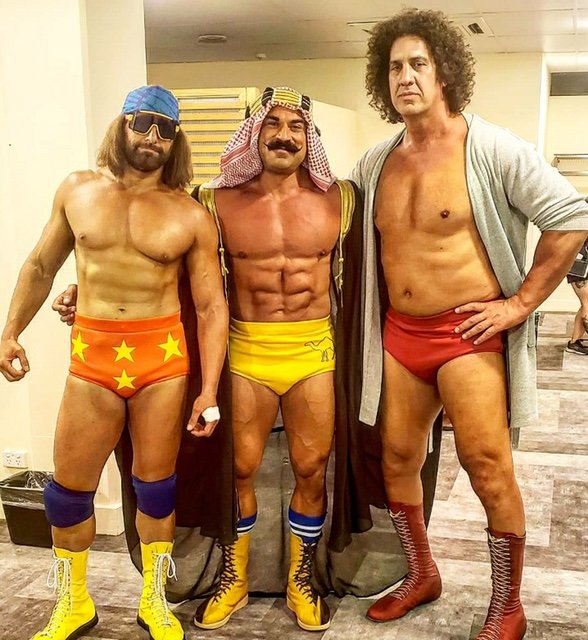
Makely, Azar, and Willig step into legendary boots in Young Rock.
“I teach specific things and I tell the guys, ‘Do not go outside of this realm, because, no offense, but you guys don’t know what you’re doing,'” he says. “I’m teaching certain things and then all of a sudden, they start punching and kicking. I understand that (they) want to look like professional wrestlers, but we started looking like guys pretending to be pro wrestlers. There’s some practices that I would videotape on my cell phone, and say to the guys, ‘Remember when I was telling you don’t do that? This is what it looks like.’ They say, ‘Oh man, that doesn’t look good,’ and I said, ‘No it doesn’t, so don’t do that. This isn’t just you looking good on camera, it’s me looking good on camera as well.'”
“I’m putting the Guerrero name on this and I can’t have crap out there.”
Still, Guerrero welcomed the enthusiasm of the actors. “I’d rather turn them down than have to turn them up,” he says. “I remember back in WWE, they would tell us it’s a lot easier to tone you down than to get you to get there. Everything that the directors asked, I was able to teach and the actors were able to do.”
Of the experience of coordinating the big battle royal scene that will be featured in tonight’s episode, Guerrero recalls the exhilaration of completing such a challenging shoot. “There were so many different moving parts,” he explains. “Really, my wrestling OCD was in overdrive. When I got done with that day I was exhausted but so fulfilled. It was a massive, massive shooting day.”
The day’s shooting included, it seems, a certain high-flying elbow drop favoured by Randy Savage and delivered by Kevin Makely. In his own Slam Wrestling interview, Makely describes his push to get that move into the show, and while Guerrero comes close to confirming Makely’s description, he holds his cards close to his chest.
“There was an instance — I don’t want to give away too much — he asked me earlier, ‘Can I do this move?’,” Guerrero recalls, without naming names. “That’s a big one. I would like to say yes. So it came to that show and the director said, ‘Do you think we’ll be able to do this move?’ I had only in between scenes to teach this move. Thank god my actor was very athletic and it came out amazing.”
When pressed to say if he’s talking about Makely and the elbow drop, Guerrero just can’t shake his no-spoiler, kayfabe instincts. “I cannot confirm or deny that,” he says with a laugh.
Guerrero’s instinct to keep kayfabe is another built-in feature of how he grew up. As part of the generation of wrestlers who watched the curtain come down and the backstage machinations of the business become part of public discourse, the third-generation wrestler has mixed feelings about the change in landscape.
“As a kid, I didn’t like it,” he says of breaking kayfabe. “Knowing how much my family protected the business, I had a lot of fights about it — was it real, was it not real. Especially back then, god they were so careful with kayfabe. Now everybody’s realizing this is very physical entertainment and there’s nothing really fake about it. I like that it’s respected more. The wrestling fan that gets it and gets really passionate about it — that’s who we’re playing to. The debate of whether it’s real or not is kind of out the window.”
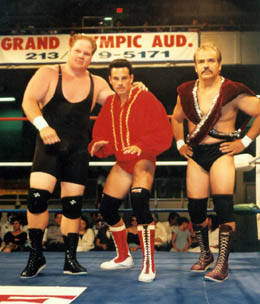
Louie Spicolli, Chavito Guerrero and Mando Guerrero pose at the Olympic Auditorium in Los Angeles. Photo by Mike Lano, wrealano@aol.com.
That has led, in Guerrero’s opinion, to a new age of wrestling on TV and in film, one that acknowledges the complexities of wrestling without getting caught up in old debates. Of older wrestling-based movies, he says: “They didn’t know how much to expose, or sometimes the people doing it didn’t really know anything. They’d either insult the wrestling fans or not tell the whole truth.”
“I think Hollywood is realizing that there’s a big market for wrestling,” he continues. “Now you have the biggest actor in the world in Dwayne Johnson, a former wrestler who embraces that wrestling sense of his. It’s not like something in a past life. And now they’re seeing just how interesting it is.”
“In Young Rock, we’re seeing the trials and tribulations of growing up in a wrestling family, and this was how I grew up.”
While film and television productions slowly approach a sense of normalcy in terms of planning future projects, Guerrero has a couple of potential jobs that he’s very excited about. Again, though, he’s wary to share details, though for a more pragmatic reason this time. “I never really talk about it until you get a check and it clears,” he laughs.
That doesn’t mean he doesn’t have other work on the go right now. “My Mexican lager (Los Guerreros) is being brewed again and is ready to come back out, bigger and better. I have a cigar company and we’re in the final stages of putting the cigars out.”
With a famous name in wrestling now gaining fame in Hollywood circles, you can rest assured that Chavo Guerrero will be lighting one of those cigars and raising a lager in celebration of his next successful project — whatever and whenever that may be.
RELATED LINKS
- Slam Wrestling’s Guerrero family story archive
- Slam Wrestling’s Young Rock review and interview archive
- NBC’s Young Rock page
- Chavo Guerrero on Twitter
